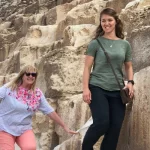Khan al-Khalili Bazaar In Cairo:
Built-in 1382 by Garkas al-Khalili, Master of Horses to Sultan Barquq, Khan al-Khalili is one of the biggest bazaars in the Middle East.
This is the oriental bazaar of fable, where gold, silver, brass and copper goods glitter enticingly in the cave-like interiors, and sacks overflowing with exotic spices fill the air with their pungent scents.
Its maze of narrow, canvas-covered alleyways is crammed with shops selling a huge variety of goods.
Here, too, traditional Egyptian crafts, such as dyeing, carving, and sewing, are practiced as they have been for centuries.
Khan al-Khalili is, of course, also a major tourist attraction. Hordes of tourists arrive here, by the coachload, to haggle and stock up on the kitsch trinkets and souvenirs that are sold in nearly every shop in the main part of the bazaar.
The bazaar grew up around several khans (also known as wikalas), which served as both warehouses and lodgings for traveling merchant caravans. Most have been swallowed up by later structures, but a few remain. On a side street off Sharia Muski, stairs lead to the upper level of the Wikala of Silahdar (1837), where the former living quarters can be made out, ranged around the central courtyard. Two carved stone gates in the Badestan area, added during the reign of Sultan al-Ghouri (1501-16), are the oldest surviving part of Khan al-Khalili.
Apart from exploring and haggling, the bazaar’s other great attraction is Fishawi’s, located in an alley one block in from Midan al-Hussein.
Open day and night for the past 200 years, it is possibly Cairo’s oldest coffee house and is crammed with small copper-topped tables, while huge antique mirrors line the walls.
Here, patrons puff on sheeshas (waterpipes) and sip mint tea round the clock.
Book your Travel Package now to know more about Egypt history.





